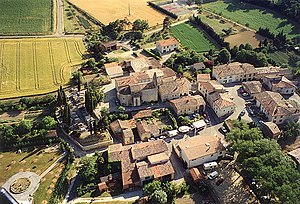Baraigne
| Baraigne | ||
|---|---|---|

|
|
|
| region | Occitania | |
| Department | Aude | |
| Arrondissement | Carcassonne | |
| Canton | La Piège au Razès | |
| Community association | Castelnaudary Lauragais Audois | |
| Coordinates | 43 ° 20 ′ N , 1 ° 49 ′ E | |
| height | 208-285 m | |
| surface | 4.76 km 2 | |
| Residents | 174 (January 1, 2017) | |
| Population density | 37 inhabitants / km 2 | |
| Post Code | 11410 | |
| INSEE code | 11026 | |
 Baraigne - the site |
||
Baraigne is a municipality in the south of France with 174 inhabitants (as of January 1, 2017) in the Aude department in the Occitania region .
location
Baraigne is located in the heart of the old cultural landscape of the Lauragais at an altitude of about 260 meters above sea level. d. M. and about 60 kilometers (driving distance) northwest of Carcassonne and about 14 kilometers west of Castelnaudary . The canton capital Salles-sur-l'Hers is about ten kilometers southwest.
Population development
| year | 1962 | 1968 | 1975 | 1982 | 1990 | 1999 | 2006 | 2016 |
| Residents | 111 | 113 | 99 | 103 | 122 | 126 | 117 | 172 |
In the 19th century the place had almost 250 inhabitants at times. The mechanization of agriculture and the associated loss of jobs has since led to a significant decline in the number of inhabitants.
economy
The area around the village is still characterized by agriculture, which in the late Middle Ages and early modern times mainly concentrated on the cultivation of woad ( pastel ). The import of indigo led to a gradual economic decline from the 18th century. At the end of the 20th century, tourism in the form of the rental of holiday apartments ( gîtes ) was added as an economic factor.
history
In 1155 the place is mentioned for the first time under the name Varanano ; In 1206 he appears in another document under his current name. In the 13th century the place was a local center of the Cathar movement ; in 1242 the assassins against the inquisitors of Avignonet-Lauragais gathered here . The reprisals that followed were horrific - among other things, the bodies of local heretics were dug up to burn in the cemetery. In the 15th century, the cultivation of woad ( pastel ) began in Baraigne , which made many places in Lauragais, also known as the ' land of milk and honey' ( pays de cocagne ) prosperous. In the years 1473 and 1480/1 there were plague epidemics . The second half of the 16th century was marked by religious disputes between Catholics and Protestants - in 1572 a large part of the churches in the wider area of Mas-Saintes-Puelles , the regional center of the Protestant movement, burned down . In Baraigne part of the nave and the bell tower were destroyed.
Attractions
- The small Romanesque parish church of Baraigne was rebuilt after the destruction in 1572 and provided with a bell gable . The area of the apse is well preserved both inside and outside ; it shows massive pilaster strips and an equally large round arch frieze below which the three windows appear to have been cut into the masonry due to the lack of accompanying columns; Inside, on the other hand, there is a richer architectural structure with three-quarter columns and blind arcades resting on smaller columns . The small church building was already recognized as a monument historique in 1908 .
- Although the castle of Baraigne with its corner turrets and defensive core still shows medieval aspects, it is dated to the 16th or 17th century due to its large window fronts. The building is privately owned; it has been recognized as a monument historique since 1948 .
- The ruins of a windmill stand on a hill, which was in operation until the early 20th century.
- In 1993, during excavations at the local cemetery, several discoidal grave steles were discovered, which vaguely recall the Basque hilarris , which were also nameless and dateless and uninterrupted .
Web links
Individual evidence
- ↑ Église Sainte-Marie, Baraigne in the Base Mérimée of the French Ministry of Culture (French)
- ↑ Château, Baraigne in the Base Mérimée of the French Ministry of Culture (French)






